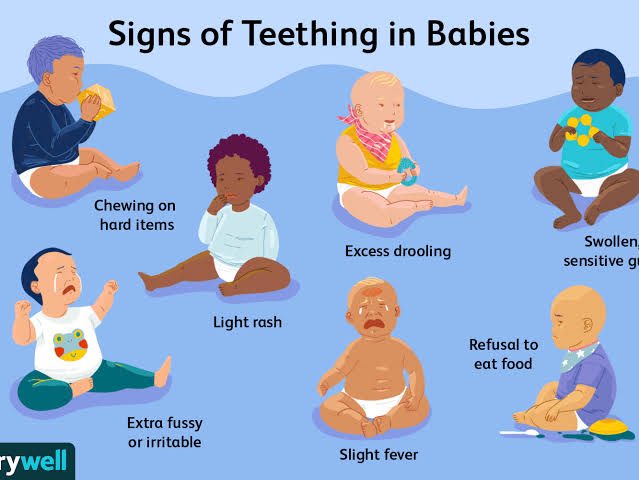When should a baby start teething. When Do Babies Start Teething? A Comprehensive Guide to Symptoms and Remedies
When do babies typically start teething. What are the common signs and symptoms of teething. How can parents soothe a teething baby. Which teething remedies should be avoided. How to properly care for a baby’s new teeth.
The Teething Process: What Every Parent Should Know
Teething, also known as odontiasis, is a natural process where a baby’s teeth begin to emerge through the gum line. This milestone in a child’s development can be both exciting and challenging for parents. Understanding the teething process is crucial for providing the best care for your little one during this potentially uncomfortable time.
When Does Teething Typically Begin?
The onset of teething can vary significantly from one baby to another. While most infants start teething between 4 and 7 months of age, some may begin earlier or later. It’s important to remember that each child develops at their own pace, and there’s no need for concern if your baby’s teeth appear on a different schedule.

Is There a Typical Order for Tooth Eruption?
While the exact timing can differ, there is a general pattern to how baby teeth emerge:
- Lower front teeth (central incisors): 6-10 months
- Upper front teeth (central incisors): 8-13 months
- Upper lateral incisors: 8-13 months
- Lower lateral incisors: 10-16 months
- First molars: 10-16 months
- Canine teeth: 16-20 months
- Second molars: 20-30 months
By the age of 3, most children will have all 20 of their primary teeth, also known as “baby teeth.”
Recognizing the Signs and Symptoms of Teething
Teething can manifest differently in each baby, but there are several common signs that parents should be aware of. Recognizing these symptoms can help you provide timely comfort and care for your teething infant.
What Are the Most Common Teething Symptoms?
- Swollen, tender gums
- Increased fussiness and crying
- Slightly elevated temperature (less than 101째F or 38.3째C)
- Desire to chew on hard objects
- Excessive drooling
- Facial rash (due to excessive drooling)
- Coughing
- Rubbing cheeks or pulling ears
- Bringing hands to mouth frequently
- Changes in eating or sleeping patterns
It’s important to note that while teething can cause discomfort, it typically doesn’t make babies sick. If your baby experiences symptoms such as diarrhea, vomiting, body rashes, high fever, or cough and congestion, these are not normal signs of teething and warrant a call to your pediatrician.
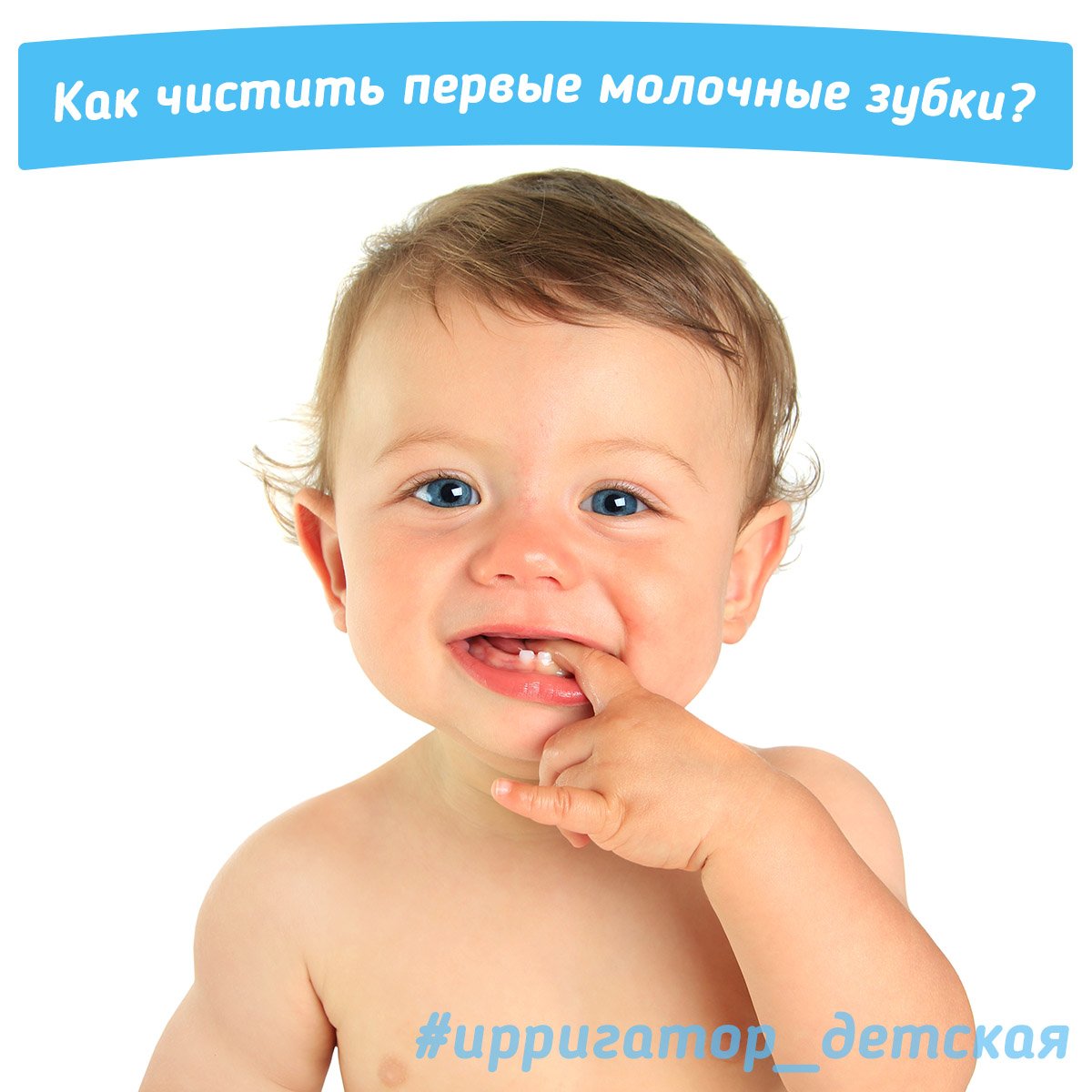
Are There Any Red Flags During the Teething Process?
While most teething symptoms are harmless, there are certain signs that require immediate medical attention. Contact your pediatrician if you observe:
- Bleeding gums
- Pus or swelling around the gums or face
- Fever above 101째F (38.3째C)
- Persistent diarrhea or vomiting
- Unusual rashes on the body
Effective Strategies to Soothe a Teething Baby
Every baby is unique, and what works for one may not work for another. Here are several safe and effective methods to help alleviate your baby’s teething discomfort:
What Are Some Safe Teething Remedies?
- Offer a cold item for your baby to chew on, such as a refrigerated (not frozen) teething ring or a clean, damp washcloth
- Provide a hard, unsweetened teething cracker (for babies over 6 months)
- Gently massage your baby’s gums with a clean finger
- For babies over 6-9 months, offer cool water in a sippy cup
- If breastfeeding, try massaging your baby’s gums with cool water before feeding to prevent nipple biting
Remember to always supervise your baby when using any teething aids to prevent choking hazards.
.png)
Teething Treatments to Avoid: Ensuring Your Baby’s Safety
While there are many safe teething remedies, some popular treatments can pose risks to your baby’s health. It’s crucial to be aware of these potentially harmful methods and avoid them.
Why Are Teething Necklaces Considered Unsafe?
Teething necklaces, including those made of amber, are not recommended by child health experts due to the risk of strangulation and choking. If you choose to use one, never place it around your baby’s neck, always supervise your baby when wearing it, and remove it when the baby is unsupervised, even for a short time.
What About Teething Gels and Medications?
Over-the-counter teething gels and liquids containing benzocaine are not recommended for children under 2 years old due to potential serious side effects. Always consult your pediatrician before giving any medication to your baby. If approved, use a small dose of children’s pain reliever, such as acetaminophen, following the doctor’s instructions precisely.

Caring for Your Baby’s New Teeth: Establishing Good Oral Hygiene
Proper oral care should begin even before your baby’s first tooth appears. Establishing good habits early on can set the foundation for lifelong dental health.
How to Care for Gums Before Teeth Appear?
Before teeth emerge, gently clean your baby’s gums at least once a day using a soft, damp washcloth or piece of gauze. This helps remove bacteria and gets your baby accustomed to having their mouth cleaned.
What’s the Best Way to Care for New Teeth?
Once teeth start to appear, brush them twice daily with a soft-bristled, infant-sized toothbrush and a tiny smear of fluoride toothpaste (about the size of a grain of rice). As your child grows, increase the amount of toothpaste to a pea-sized dollop around age 3.
Teething and Overall Health: Understanding the Connection
While teething is a normal part of development, it’s important to understand how it can affect your baby’s overall health and well-being.
Can Teething Affect Sleep Patterns?
Teething discomfort can sometimes disrupt a baby’s sleep. You might notice your little one waking more frequently or having trouble settling down. Offering comfort measures before bedtime and maintaining a consistent sleep routine can help minimize these disruptions.
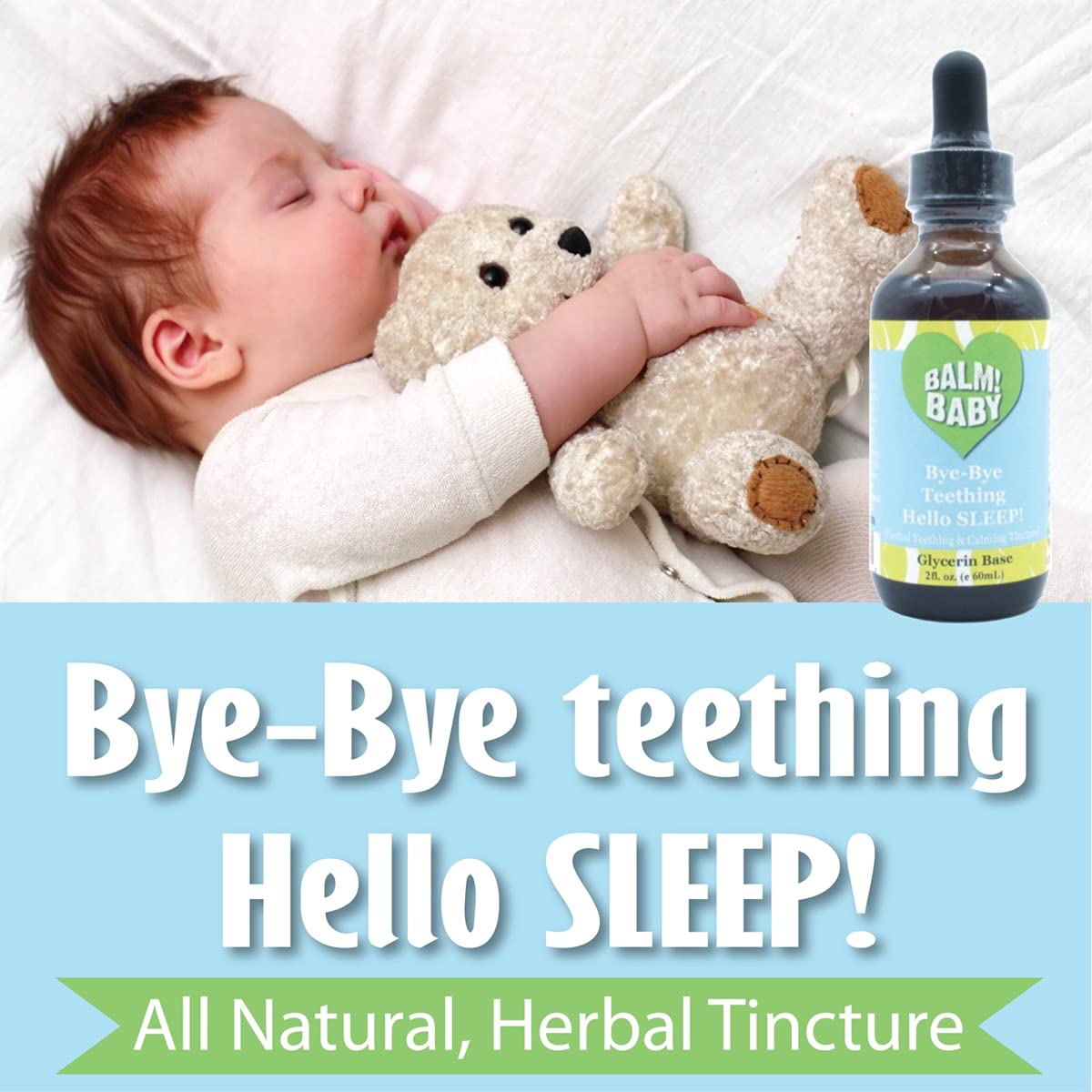
How Does Teething Impact Eating Habits?
Some babies may experience a temporary decrease in appetite during teething due to sore gums. Offering softer foods and cooler temperatures can help. If you notice a significant change in your baby’s eating habits or weight, consult your pediatrician.
Teething Myths Debunked: Separating Fact from Fiction
There are many misconceptions surrounding teething. Let’s address some common myths to ensure you have accurate information.
Does Teething Cause Fever and Diarrhea?
While teething may cause a slight increase in body temperature, it doesn’t typically cause high fever or diarrhea. These symptoms, if present, are more likely due to an unrelated illness and should be evaluated by a healthcare provider.
Are Teething Tablets Safe and Effective?
The FDA has warned against the use of homeopathic teething tablets due to potential health risks. There’s no scientific evidence supporting their effectiveness, and some may contain harmful ingredients. Always consult your pediatrician before using any teething remedies.
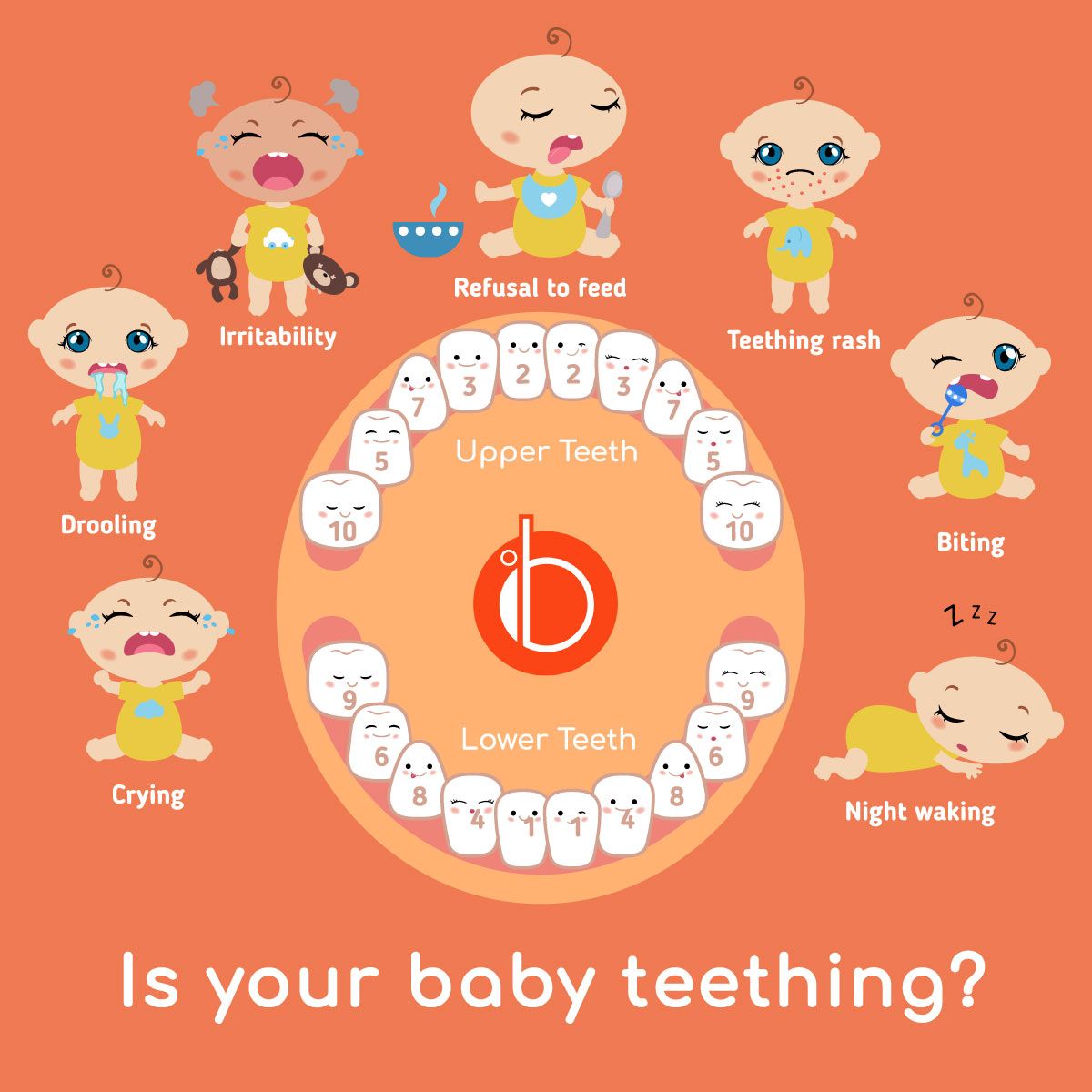
When to Consult a Pediatric Dentist: Ensuring Proper Dental Development
Regular dental check-ups are crucial for maintaining your child’s oral health and catching any potential issues early.
When Should a Baby Have Their First Dental Visit?
The American Academy of Pediatric Dentistry recommends scheduling your baby’s first dental visit by their first birthday or within six months after their first tooth appears, whichever comes first. This early visit helps establish a “dental home” and allows the dentist to monitor your child’s oral development.
What If Baby Teeth Don’t Appear on Schedule?
While there’s a wide range of normal when it comes to teething, if your baby hasn’t developed any teeth by 18 months, it’s advisable to consult a pediatric dentist. They can assess your child’s oral development and address any concerns.
Remember, every baby’s teething experience is unique. By understanding the process, recognizing symptoms, and knowing how to provide safe relief, you can help your little one navigate this important milestone with comfort and care. Always consult your pediatrician or dentist if you have concerns about your baby’s teething process or oral health.
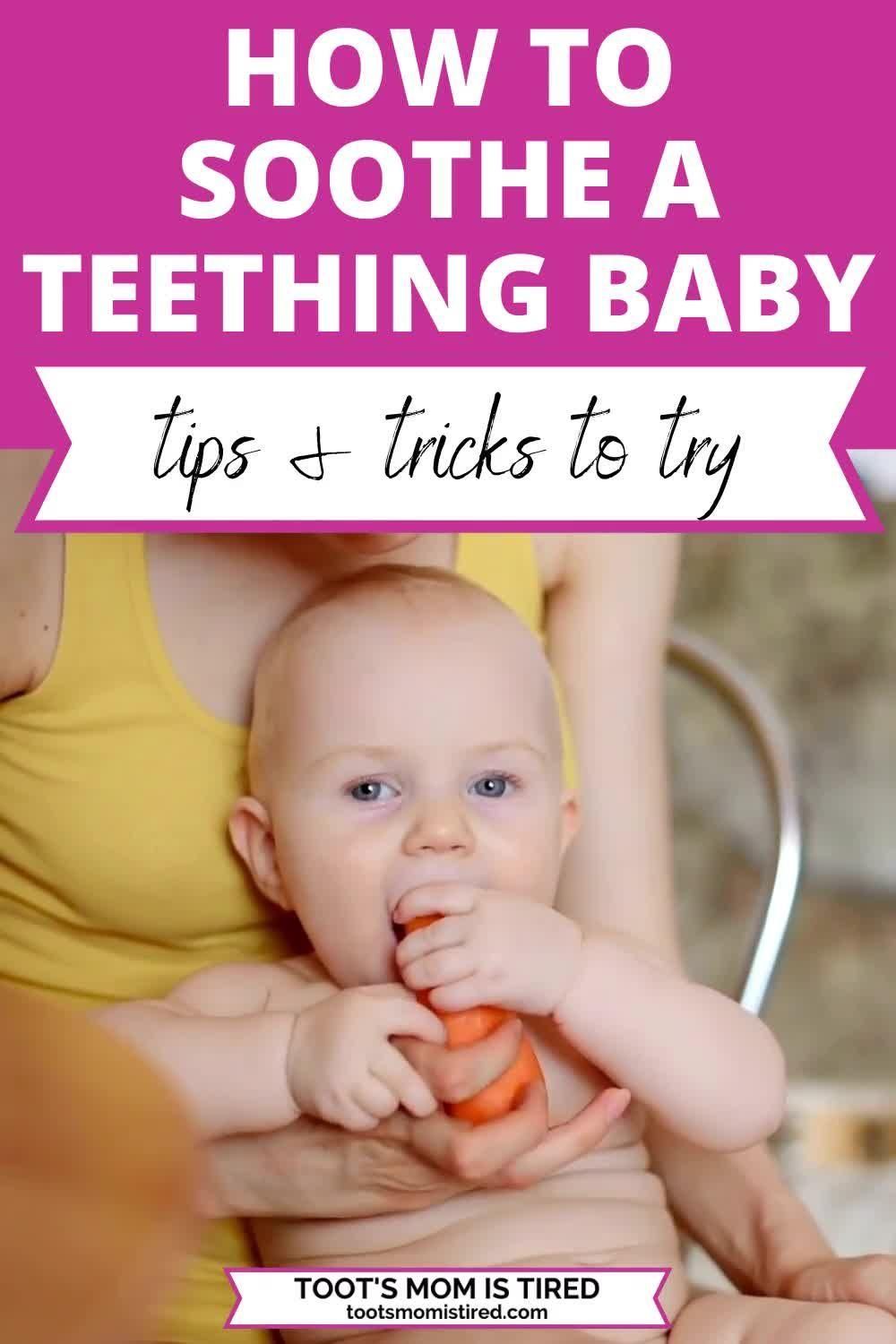
Teething in Babies: Symptoms and Remedies
Written by WebMD Editorial Contributors
In this Article
- What Is Teething?
- When Do Babies Start Teething?
- Signs and Symptoms of Teething
- Order of Tooth Eruption
- Soothe a Teething Baby
- Treatments to Avoid
- Teething Necklaces
- Teething Medicine
- How to Care for Baby’s New Teeth
Teething is when your baby’s teeth start to come through their gum line. Another word for it is odontiasis.
Most babies begin to teethe between 4 and 7 months old, but some start much later. There’s no need to worry if your baby’s teeth come in on another timetable — it can be different for every baby.
The symptoms aren’t the same for every baby, but they may include:
- Swollen, tender gums
- Fussiness and crying
- A slightly raised temperature (less than 101 F)
- Gnawing or wanting to chew on hard things
- Lots of drool, which can cause a rash on their face
- Coughing
- Rubbing their cheek or pulling their ear
- Bringing their hands to their mouth
- Changes in eating or sleeping patterns
Teething can be painful, but it doesn’t usually make babies sick. Call your doctor if your baby has diarrhea, vomiting, rashes on the body, a higher fever, or cough and congestion. These aren’t normal signs of teething.
Call your doctor if your baby has diarrhea, vomiting, rashes on the body, a higher fever, or cough and congestion. These aren’t normal signs of teething.
You also should call the pediatrician if your baby’s gums are bleeding or you see any pus or swelling of their face.
When and how teeth come in can be different for every baby and may be based on family history. But most of the time, the lower front two teeth come in first between 6 and 10 months, followed by the opposite top two teeth and the two on either side of those between 8 and 13 months. Next come the two on either side of the bottom front teeth, then the first molars appear between 10 and 16 months. The teeth in front of the first molars are next, and the back molars are the last ones to come in.
In all, 20 “baby teeth” will eventually be in place, usually by age 3.
What works to soothe a friend’s baby might not work for yours. You may need to try different things to help your little one feel better:
- Something cold in your baby’s mouth, like a cold pacifier, spoon, clean wet washcloth, or a solid (not liquid) refrigerated teething toy or ring.
 Some experts say frozen teething toys are too cold and may hurt your baby’s mouth. Make sure to clean teething toys, washcloths, and other items after the baby uses them.
Some experts say frozen teething toys are too cold and may hurt your baby’s mouth. Make sure to clean teething toys, washcloths, and other items after the baby uses them. - Try offering a hard, unsweetened teething cracker.
- If your baby is older than 6-9 months, you can offer cool water from a sippy cup, too.
- Massage the gums by gently rubbing them with your clean finger. If the teeth haven’t come in yet, you can let your baby gnaw on your finger. If you’re nursing your baby, try dipping your fingers in cool water and massaging their gums before each feeding. That may keep them from biting your nipple while nursing.
Never put anything in your baby’s mouth that isn’t specifically approved to help soothe teething. Even some products described as teethers or teething aids aren’t safe choices, including ones:
- Filled with liquid that can tear and spill
- Made of breakable material, like plastic, that can possibly lead to choking
- That are frozen solid — these can be too hard on a baby’s mouth
Another reason to be aware of the material used to make the teethers: Some can be made from harmful substances, like lead. Look for ones made of rubber.
Look for ones made of rubber.
Child health experts don’t recommend teething necklaces. They’re dangerous: They can strangle the baby. They also can choke if the necklace breaks and they swallow the beads.
If you do choose to use one, make sure to:
- Put it on a wrist or ankle, not around the baby’s neck.
- Always watch your baby when they wear it.
- Take it away when you aren’t watching your baby, even for a very short time.
You may have heard that amber teething necklaces release a pain reliever when heated. That’s not proven, and doctors say using one is not a good idea.
Medicine that you rub on your baby’s gums to stop the pain of teething may not help. It quickly washes away in the mouth and may numb the back of their throat and make it hard for them to swallow.
Stay away from over-the-counter teething gels and liquids that have the ingredient benzocaine. The FDA says this ingredient shouldn’t be given to children under 2. It can cause rare but serious side effects.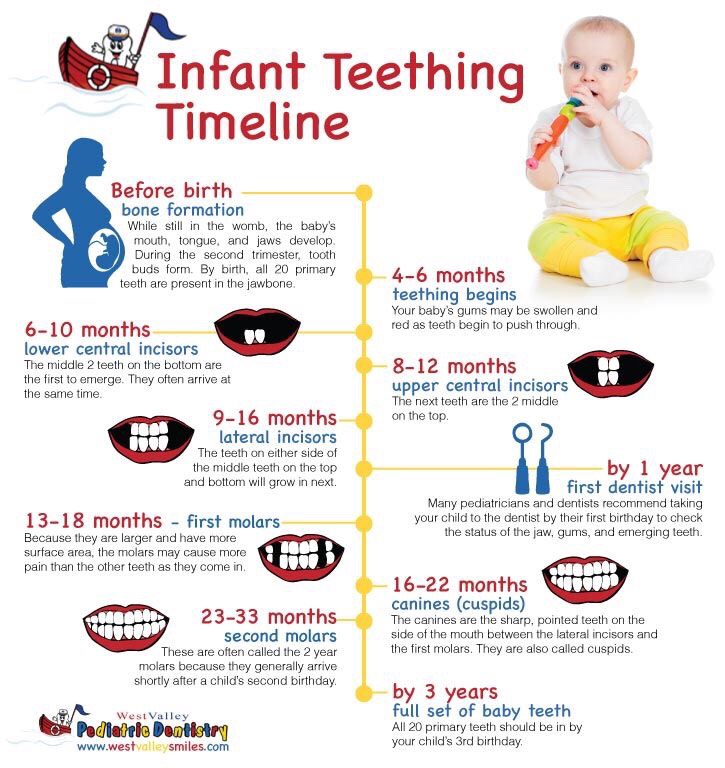
A small dose of a children’s pain reliever, such as acetaminophen, may help your baby. Don’t use ibuprofen for an infant under 6 months old, and ask your doctor before giving your baby any medication. Use it exactly as the doctor says.
Teething can be rough for you and your baby at first. But it’ll get easier as you both learn how to soothe each new tooth that pops out.
Good oral hygiene is important, even before your baby has teeth:
- Until teeth start to come in, clean your baby’s gums with a wet washcloth or piece of gauze at least once a day.
- Once they have teeth, clean your baby’s mouth the same way at least twice a day. After feedings is a good time for this.
- After their first birthday, you can start to use a soft-bristled baby toothbrush with water and a small amount of toothpaste that doesn’t have fluoride in it. You can also start flossing between their teeth.
Your child should see a pediatric dentist when the first tooth appears, or no later than their first birthday.
Top Picks
Teething in Babies: Symptoms and Remedies
Written by WebMD Editorial Contributors
In this Article
- What Is Teething?
- When Do Babies Start Teething?
- Signs and Symptoms of Teething
- Order of Tooth Eruption
- Soothe a Teething Baby
- Treatments to Avoid
- Teething Necklaces
- Teething Medicine
- How to Care for Baby’s New Teeth
Teething is when your baby’s teeth start to come through their gum line.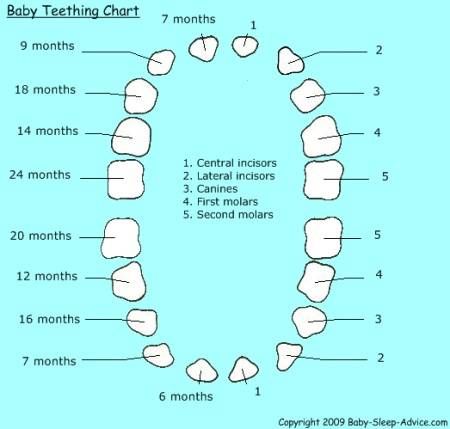 Another word for it is odontiasis.
Another word for it is odontiasis.
Most babies begin to teethe between 4 and 7 months old, but some start much later. There’s no need to worry if your baby’s teeth come in on another timetable — it can be different for every baby.
The symptoms aren’t the same for every baby, but they may include:
- Swollen, tender gums
- Fussiness and crying
- A slightly raised temperature (less than 101 F)
- Gnawing or wanting to chew on hard things
- Lots of drool, which can cause a rash on their face
- Coughing
- Rubbing their cheek or pulling their ear
- Bringing their hands to their mouth
- Changes in eating or sleeping patterns
Teething can be painful, but it doesn’t usually make babies sick. Call your doctor if your baby has diarrhea, vomiting, rashes on the body, a higher fever, or cough and congestion. These aren’t normal signs of teething.
You also should call the pediatrician if your baby’s gums are bleeding or you see any pus or swelling of their face.
When and how teeth come in can be different for every baby and may be based on family history. But most of the time, the lower front two teeth come in first between 6 and 10 months, followed by the opposite top two teeth and the two on either side of those between 8 and 13 months. Next come the two on either side of the bottom front teeth, then the first molars appear between 10 and 16 months. The teeth in front of the first molars are next, and the back molars are the last ones to come in.
In all, 20 “baby teeth” will eventually be in place, usually by age 3.
What works to soothe a friend’s baby might not work for yours. You may need to try different things to help your little one feel better:
- Something cold in your baby’s mouth, like a cold pacifier, spoon, clean wet washcloth, or a solid (not liquid) refrigerated teething toy or ring. Some experts say frozen teething toys are too cold and may hurt your baby’s mouth. Make sure to clean teething toys, washcloths, and other items after the baby uses them.

- Try offering a hard, unsweetened teething cracker.
- If your baby is older than 6-9 months, you can offer cool water from a sippy cup, too.
- Massage the gums by gently rubbing them with your clean finger. If the teeth haven’t come in yet, you can let your baby gnaw on your finger. If you’re nursing your baby, try dipping your fingers in cool water and massaging their gums before each feeding. That may keep them from biting your nipple while nursing.
Never put anything in your baby’s mouth that isn’t specifically approved to help soothe teething. Even some products described as teethers or teething aids aren’t safe choices, including ones:
- Filled with liquid that can tear and spill
- Made of breakable material, like plastic, that can possibly lead to choking
- That are frozen solid — these can be too hard on a baby’s mouth
Another reason to be aware of the material used to make the teethers: Some can be made from harmful substances, like lead. Look for ones made of rubber.
Look for ones made of rubber.
Child health experts don’t recommend teething necklaces. They’re dangerous: They can strangle the baby. They also can choke if the necklace breaks and they swallow the beads.
If you do choose to use one, make sure to:
- Put it on a wrist or ankle, not around the baby’s neck.
- Always watch your baby when they wear it.
- Take it away when you aren’t watching your baby, even for a very short time.
You may have heard that amber teething necklaces release a pain reliever when heated. That’s not proven, and doctors say using one is not a good idea.
Medicine that you rub on your baby’s gums to stop the pain of teething may not help. It quickly washes away in the mouth and may numb the back of their throat and make it hard for them to swallow.
Stay away from over-the-counter teething gels and liquids that have the ingredient benzocaine. The FDA says this ingredient shouldn’t be given to children under 2. It can cause rare but serious side effects.
A small dose of a children’s pain reliever, such as acetaminophen, may help your baby. Don’t use ibuprofen for an infant under 6 months old, and ask your doctor before giving your baby any medication. Use it exactly as the doctor says.
Teething can be rough for you and your baby at first. But it’ll get easier as you both learn how to soothe each new tooth that pops out.
Good oral hygiene is important, even before your baby has teeth:
- Until teeth start to come in, clean your baby’s gums with a wet washcloth or piece of gauze at least once a day.
- Once they have teeth, clean your baby’s mouth the same way at least twice a day. After feedings is a good time for this.
- After their first birthday, you can start to use a soft-bristled baby toothbrush with water and a small amount of toothpaste that doesn’t have fluoride in it. You can also start flossing between their teeth.
Your child should see a pediatric dentist when the first tooth appears, or no later than their first birthday.
Top Picks
A child’s teeth grow out of order – what to do, who to contact?
The first teeth are a long-awaited and exciting event. It brings with it joy – and anxiety if it doesn’t go according to plan. Any pediatric dentist will say that teething not according to the established pattern is a variant of the norm. But parents are still worried: maybe this is an alarming symptom?
Among the reasons why teeth erupt out of order and out of time, there can really be serious illnesses: rickets, dyspepsia. But they are always accompanied by more characteristic symptoms.
But they are always accompanied by more characteristic symptoms.
For example, with rickets, the baby sweats a lot, especially in the head area, lags behind in physical development, is naughty a lot, is afraid of bright light. Dyspepsia is accompanied by a distinct disorder of the gastrointestinal tract: the child’s stool changes, severe colic is observed. It is impossible to miss these symptoms.
Therefore, problems in pediatric dentistry are not a reason to suspect a serious diagnosis.
When you should definitely not worry:
- If the family has already had a case of “wrong” teething. The timing and order of the appearance of milk teeth are genetically determined. If a child’s teeth grow out of order and the parents or grandparents had the same feature, there is nothing to worry about.
- In difficult childbirth and if the child was ill in the first days or months of life. While he is recovering, temporary problems in pediatric dentistry may appear – the body simply does not have enough resources to compensate for all birth disorders at once.

- If the child is generally healthy, eats fully and walks. This makes it possible to exclude complex disorders in the development and formation of the skeleton.
The order of appearance of teeth was formed in the course of evolution. To date, pediatric dentistry has accumulated a lot of data on this interesting topic. Marine predators have the same teeth – conical, so that it is convenient to grab slippery prey. And in land mammals, they were divided into incisors, canines, premolars and molars.
Ask a pediatric dentist to tell your child how teeth have changed depending on their purpose. Fangs served for protection, sharp incisors helped to bite off food, and powerful molars helped to chew. Depending on the species, the order of the appearance of teeth developed: for example, in puppies and wolf cubs, fangs appear first, because they are predators.
Man quickly became an omnivore, mastered hunting and farming. This is one of the answers to the question why baby teeth in children can erupt out of order. We are no longer tied to the evolutionary code, so we have many variants of the norm.
We are no longer tied to the evolutionary code, so we have many variants of the norm.
Science does not yet know the exact answer. But it is known for sure that it is impossible to influence the order of appearance of teeth. No pediatric dentist will be able to prescribe medications or procedures to make teeth fit “correctly” or to speed up their growth. The only working strategy is to wait and monitor the health of the child as a whole.
Sometimes parents are concerned not with the order, but with the timing of eruption. On average, milk teeth appear about 6 months. Deviations of three months in both directions are normal. You can show your child to a pediatric dentist if the baby got teeth at three months or did not appear at eight, but both situations fit into the norm.
Possible reasons for the delay:
- heredity;
- difficult childbirth, diseases of newborns;
- congenital or genetic diseases (always have other, more characteristic symptoms).

It is believed that the rate of appearance of teeth is influenced by the method of feeding and complementary foods. However, it has not received official confirmation in pediatric dentistry. The child needs good nutrition, and from what source is not so important.
Can teeth not erupt at all? They can. In 1% of cases, pediatric dentists diagnose congenital adentia. It is associated with ectodermal dysplasia, a serious tissue pathology, which is also accompanied by underdevelopment of hair and nails, skeletal deformity, and other noticeable problems. If your child does not have the listed signs, then the delay in teething is temporary and they will definitely appear soon.
So, the timing and order of appearance of milk teeth is very variable. And their mutual arrangement in the oral cavity is not. If your teeth grow crooked, uneven, you should contact a pediatric dentist. Crooked teeth are a sign of malocclusion, which can lead to serious problems.
Why malocclusion is harmful:
- The risk of caries increases due to the fact that adjacent teeth press against each other.

- Diction is broken, it will be difficult for a child to master sounds.
- Possible pain in the jaw area due to muscle strain.
- Smile looks unaesthetic.
- In severe cases, the oval of the face changes, headaches develop.
Most bite defects are easily corrected in a pediatric dental clinic with plates or braces. Usually, correction is started at the age of 5-6, after the change of teeth to permanent ones. But if the location of milk teeth (milk bite) is significantly outside the norm, the pediatric dentist will offer a plate or cap.
Why correct milk bite?
- It will be easier for a child to master speech and to establish diction.
- The masticatory muscles and articulatory apparatus will develop correctly.
- Reduces the risk of misalignment of permanent teeth.
- Individual features, heredity.
- Complications during childbirth and during the neonatal period.
- Chronic diseases (always have other, more characteristic symptoms).

Let’s sum it up: the time and order of the appearance of teeth may differ from the generally accepted ones. This is normal, not dangerous and will not cause problems in the future.
It is worth contacting a pediatric dentist if the teeth grow unevenly, as this indicates an abnormal bite. The bite is usually corrected after 6 years, on permanent teeth. Milk bite is corrected only in case of severe pathologies that affect the health and development of the child as a whole.
It is possible to identify problems in time only in pediatric dentistry, where doctors have experience working with babies. It is very important not only to understand the features of the formation of the milk dentition, but also to conduct an examination carefully and accurately. Many babies are afraid of strangers, and the doctor’s approach is very important.
“Mira” is a children’s dental clinic where they work with patients of any age. We pay much attention to the comfort of our little visitors.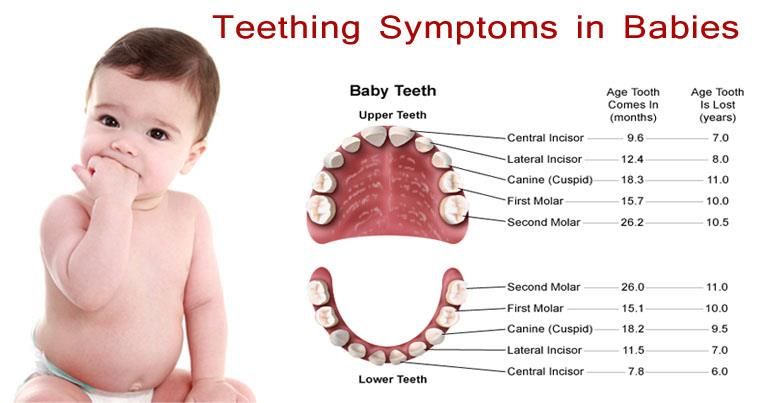 The sooner the kid visits the dentist and makes sure that treating his teeth is not painful and not scary, the less likely it is to start health in the future. And you will be sure that we will not miss real problems and will not make a false diagnosis.
The sooner the kid visits the dentist and makes sure that treating his teeth is not painful and not scary, the less likely it is to start health in the future. And you will be sure that we will not miss real problems and will not make a false diagnosis.
Mira is your children’s dental clinic. Contact.
Change of milk teeth to permanent ones: what is important to know?
Many parents still think that pediatric dentistry is needed only in exceptional cases: if the child has a severe toothache and the pain does not go away by itself. There is also an opinion that there is no need to do anything with milk teeth, because they will fall out anyway and give way to molars. These are erroneous opinions that the doctors of our clinic would even call dangerous.
Why does a child need a pediatric dentist? First of all, for preventive examinations and monitoring of the growth of teeth, their change. Many factors influence the health of milk teeth. In turn, the health of the first teeth affects the condition of the molars even before they erupt. Next, we will understand how the change process takes place. Every parent should know this to help their little one get straight, beautiful teeth and not experience problems as an adult.
Next, we will understand how the change process takes place. Every parent should know this to help their little one get straight, beautiful teeth and not experience problems as an adult.
If you are still not accustomed to taking your child to the pediatric dentist once every six months, it’s time to write down the date of the next visit in the calendar and make an appointment in advance at our clinic. This simple action will help prevent unpleasant problems, positively affect the formation of bite and oral health.
In addition, getting to know the doctor early will help children form a good impression of the clinic. Caring for teeth in Mira children’s dentistry in Krasnoyarsk will be associated with something festive and exciting! This is completely opposite to the situation when you bring a baby to the clinic with a severe toothache that requires treatment. A visit to the dentist will inevitably be remembered as something unpleasant.
The first teeth during eruption will cause discomfort in the child, and this is a natural process. During this period, salivation increases, a runny nose may occur due to the eruption of the upper teeth. The normal pace involves the appearance of new teeth every few weeks.
During this period, salivation increases, a runny nose may occur due to the eruption of the upper teeth. The normal pace involves the appearance of new teeth every few weeks.
Be prepared for the fact that the child will be capricious and refuse to eat, he may have a fever. In order to facilitate this period, you can use special teething toys. During this period, the gums become inflamed and cause discomfort – they can itch and hurt. Talk to your dentist: There are safe cooling gels for children that can help reduce the intensity of teething and teething symptoms in children.
It is also recommended to replace drinks with plain water. Juices and other drinks that contain sugar create an acidic environment in the mouth. Because of this, an inflammatory process can begin. Care should be taken to disinfect pacifiers and toys that children may place in their mouths.
The first teeth appear at the age of six months. The first chewing teeth appear at the age of 1 to 1. 5 years. Fangs are cut in a period of up to 2 years. After that, by the age of 3, the following chewing teeth appear. Each new group requires attention. So, it is important to clean chewing teeth well after eating, since the enamel of milk teeth is quite weak. Food retention on the surface can easily cause inflammation.
5 years. Fangs are cut in a period of up to 2 years. After that, by the age of 3, the following chewing teeth appear. Each new group requires attention. So, it is important to clean chewing teeth well after eating, since the enamel of milk teeth is quite weak. Food retention on the surface can easily cause inflammation.
It is also important to make sure that the child weaned from the pacifier and stopped putting his fingers in his mouth. If this does not happen, an incorrect bite will be formed.
At the age of about 5 years, milk teeth begin to fall out, giving way to molars. It is important not to stimulate this process. It is not necessary to remove teeth, as this will negatively affect the growth of molars. In exceptional cases, the doctor may prescribe surgery if there is severe caries, too early or late eruption.
If a tooth is loose and about to fall out, no help is needed. It is better to take the baby to the doctor to get an individual recommendation and confidence that the processes are going naturally.
Do not forget to take your child to the doctor about once every 3 months in order to carry out mineralization, fluoridation and treatment of caries in time. If the pain during teething is very strong, it is allowed to give painkillers to children.
After the age of 3, parents can take a break from the changes. And then, at about 5 years of age, milk teeth are replaced by permanent ones. The process begins with the lower incisors. Then, after about a year, chewing “sixes” are cut, which parents may mistakenly take for dairy. A year later, the upper incisors change.
To make this journey with your child without problems and pain, visit the dentist regularly. Children may experience pain simply from jaw expansion. The doctor can easily tell you the cause of the discomfort. The age of 6-7 years shows the prospect of bite formation. Here you can quickly fix the problems that arise so that by adolescence the child has an even beautiful smile.
Further, the procedure for replacing milk teeth continues with the upper lateral incisors by 8 years. aged 9-10 years old, the primary first premolars appear, and a year later they are followed by the second premolars. 12-13 years old is the age of the appearance of fangs, and at 14 years old the last second molars are cut.
aged 9-10 years old, the primary first premolars appear, and a year later they are followed by the second premolars. 12-13 years old is the age of the appearance of fangs, and at 14 years old the last second molars are cut.
The procedure for replacing milk teeth ends with the full formation of a bite in the amount of 24 teeth.
It is recommended to bring your baby to the dentist as soon as the first tooth begins to cut. In some cases, if there are problems, this should be done earlier. You already know that adults are advised to visit the dentist once every six months to prevent and treat problems in the early stages.
Speaking about children, they need preventive meetings with the doctor more often. The growth, condition and change of teeth in children must be carefully monitored. Milk teeth are less resistant to caries, therefore, to detect inflammatory processes in the early stages, you need to go to the dentist more often.
Of course, any unpleasant symptom in the oral cavity requires a visit to a doctor.

 Some experts say frozen teething toys are too cold and may hurt your baby’s mouth. Make sure to clean teething toys, washcloths, and other items after the baby uses them.
Some experts say frozen teething toys are too cold and may hurt your baby’s mouth. Make sure to clean teething toys, washcloths, and other items after the baby uses them.


